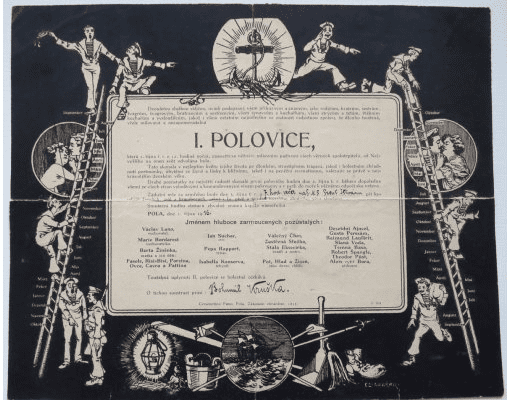The photo gallery is located in our museum archive.
Go to archive
VWar ship mail - SZENT ISTVÁN - an extraordinary unit of a Czech sailor serving on this ship
An extraordinary unit of one sailor... Bohumil Kruška, who first went through a naval school and then served until the unfortunate end on the Austrian warship SZENT ISTVÁN. There are extraordinary exhibits as depicted in the pictures …. rare and unknown in Marina . This set also includes a set of memories - About my service on the ship. It will be published in a short time horizon.
ts name will be: Sinking c.k. battleship Szent István
| The battleship Szent István of the Austro-Hungarian Navy was a "Dreadnought" type of ship. In the Austro-Hungarian Navy, the ship belonged to the Tegetthoff class of battleships. (According to the admiral who fought a victorious battle with the Italian fleet off the island of Vis in 1866). For the last time in history, warships won here with the help of clowns - pointed bows destroying the enemy's ship with a battering ram.) In 1906, a new generation battleship was launched in England. Her name Dreadnought was already used once by a successful English warship in the 16th century. The Dreadnought outclassed older generation battleships with the firepower of its 30 cm cannons with a range of 20 km and speed. She matched them in armor. The English then learned from the defeat of the Russian fleet in the Battle of Tsushima. Dreadnought-type ships dominated the seas and oceans in the period 1906-1918. Rakousko-Uhersko uvedlo do služby první loď třídy Tegetthoff v roce 1912. Byla to známá loď „Viribus Unitis“. Postavila ji loděnice STT v Terstu .Část výzbroje lodi včetně kanonů dodala tehdy Škoda Plzeň. Sesterské lodi Viribus Unitis byly také postaveny v Terstu a jmenovaly se Tegetthoff a Prinz Eugen. Čtvrtá a poslední loď této třídy, Szent István, byla zpočátku stavěna ve Rijece a dokončena v Pule v roce 1915. V dokumentech té doby je Rijeka označována italských jménem Fiume. The name of the ship, Szent István (pronounced: sent ištván), means Saint Stephen in Hungarian. Coincidentally, the border between Austro-Hungarian Zalitavsk (Hungarians) and Předlitavsk (Countries represented in the Reich Council) ran precisely through Rijeka (Fiume). King Stephen ruled the Hungarians from 1000-1038. The Prague bishop Vojtěch from the Slavníkov family wanted to avenge the murder of his family by the ruling Přemyslovs and the Vrsovs helping them. At that time, the Przemysl family controlled the mountainous territory of Slovakia and today's southern Poland, including Kraków. We can assume that it was also revenge that led Vojtěch to convert King Stephen to Christianity in Esztergom and thus add legitimacy to the Hungarian control of the Carpathian basin. Vojtěch practically closed the possibility of further expansion of the state to the Přemyslovs. Most of today's historians rate the importance of Saint Adalbert highly, as a "great European" of his time. The battleship Szent István was 152.2 m long, 27.99 m wide, and 8.85 m deep. Twelve 30.5 cm caliber guns were placed in four gun turrets. Another twelve guns had a caliber of 15 cm. Eighteen light guns were of 7.5 cm caliber. The protective armor had a strength of 280 mm. Twelve steam boilers and four propellers allowed the ship to reach a speed of 20 knots. Since the ship was not completed until 1915, during the war, war reasons did not allow the crew to be trained on the open sea. While the other Tegetthoff-class battleships made sorties against the Italian coast, Szent István remained locked in the bay of the port of Pula. In 1914, the Entente fleet closed the Strait of Oranto (between Albania and Italy). The strait was even closed with an anti-submarine net. C. K. the navy tried to breach the seal several times during the First World War, most seriously in 1917, but the forces of the c.k. navies were not enough. The majority of the fleet therefore remained closed in the port of Pula (then Pola) and in the Boca Kotorska (then Bocca di Cattaro) for the duration of the war. The fleet was a potential obstacle to the landing of the treaty powers on the Dalmatian coast. The calm level of waiting for the enemy was changed in February 1918 by the rebellion in Boka Kotorska. The wartime leadership interpreted the causes of the rebellion as the result of long inactivity and war weariness. Fleet management was replaced and partially retired. Rear Admiral Miklós Horty, whom we rather know as the head of the Hungarian state in the years 1920-1944, was appointed head of the navy. After taking over the fleet, Horty planned a complex, risky operation that would allow c.k. navy to take the initiative in the Straits of Oranto. The strongest ships of the fleet were to move secretly and with a small escort to Bay of Kotorska and from there surprise the ships closing the Orant Strait. The battleships Viribus Unitis and Prinz Eugen set sail with a small escort from Pula on 8 June 1918 at night. The next day they were followed by the ships Szent István and Tegetthoff. The operation had many weaknesses. One of them was that the ships could leave the port in Pula only at 10:15 p.m. They waited until dark (at 9 p.m.) and only then was the order given to remove the anti-submarine nets closing the port. After leaving the harbor, the battleships Szent István and Tegetthoff took a southeasterly course along the Adriatic coast. According to the plan, the ships were supposed to anchor in Telaščica Bay on the island of Dugi Otok in the morning and only continue to Bay of Kotor the next night. The destroyer Velebit was at the head of the small battle formation, followed by the battleship Szent István surrounded by six torpedo boats, followed by Tegetthoff and again by torpedo boats. Captain Seitz, the formation commander, ordered the ships' speed to be increased to 17.5 knots. He wanted to make up for the loss of time caused by the uncoordinated opening of the anti-submarine nets at the entrance to the port of Pula. Although the battleships could reach speeds of up to 20 knots, the crew was untrained. It so happened that shortly after midnight the speed of the entire group had to be reduced to 12 knots due to overheating of one of the steam engines on the battleship. At the level of the island of Susak near the larger island of Lošinj at 2 o'clock the speed could be increased again to 14 knots. The sea was very calm, the sky clear. Visibility was very good in the eastern direction, a foggy haze lay over the wide Adriatic in the western direction. Overheating of steam engines, marginal increase in performance together with an untrained crew was externally manifested by excessive smoke from the chimneys. Thick black smoke was rising into the sky, which could be seen really far away. At 3:30 a.m., c.k. the battle formation was located northwest of the island of Premuda. This night there were 2 Italian MAS class torpedo boats lying in wait off Premuda Island. They waited here for irregularly sailing Austrian steamers supplying Boka Kotor. MAS torpedo boats already had a quiet and powerful gasoline engine. Each torpedo boat was armed with two torpedoes. They set sail from the port of Ancona and, thanks to the calm sea, could cross the entire Adriatic in the dark of night. At 3:15 a.m. the crews of the Italian torpedo boats saw black smoke in the sky. It was already just before dawn. Captain Luigi Rizzo, commander of the battle group, did not hesitate for a moment. Within 15-20 minutes, the boat MAS 15 was able to sneak completely undetected between the obsolete Austrian torpedo boats up to a distance of 300 m from the starboard side of the battleship Szent István. With a ship length of 150 m, it is clear that the target of a torpedo attack is really big. Szent István was hit by both torpedoes. The observers on the Szent István saw the trajectory of the torpedoes only at the last moment. Two massive explosions followed. In no time, the ship listed 10 o to starboard. The second MAS boat fired its torpedoes at the battleship Tegetthoff and missed. It was probably also from a greater distance. The Italian torpedo boats were spotted by only one Austrian torpedo boat in their rapid retreat. So he fired his torpedoes at them, but of course missed the fast boats. The cannons of the battleships with a range of 20 km remained inactive because the attackers were invisible. Paradoxically, the fragile fast boat could have been threatened by machine gun fire, but it was not used. The MAS boats arrived in Ancona at 7:00 a.m. Today, the Italian fast boat MAS 15 is on display in the Sacrario delle Bandiere museum in Rome. The wounded battleship Szent István continued her voyage at a speed of 4.5 knots. However, she soon had to stop completely because 10 steam boilers had to be extinguished due to water entering the ship. The remaining 2 steam boilers provided energy for the water pumps. Despite the closure of the ship's bulkheads, however, water continued to enter the ship through the channel for the electrical installation. The battleship Tegetthoff attempted to take Szent István in tow, but several false submarine alarms made it impossible to take advantage of the running time. The ship's guns were turned to port to balance the penetrating water. As the ship took on more and more water, it was necessary to extinguish the last 2 steam boilers. This made the situation hopeless as the water pumps stopped working. That's when the order was announced: "Abandon the ship!" While the sailors jumped into the sea in panic, the entire sinking of the Szent István was photographed and filmed from the nearby ship Tegetthoff. The film shows some sailors climbing the hull of the ship. At 6:05 a.m. (June 10, 1918), the Szent István battleship suddenly turned and remained on the surface with its keel up. However, this did not last long. After 6 minutes of agony, the ship disappeared under the surface of the sea. An hour later, escort ships were picking up floating sailors from the surface. 89 men died when the ship sank. The offensive operation in the Strait of Oranto was called off because the engagement at Premuda Island was the intention of c.k. marines betrayed and the attack formation's firepower was reduced by 25% by the sinking of the battleship Szent István. Ostatní bitevní lodi zůstaly až do konce války v přístavu Pula. Po kapitulaci Rakouska-Uherska převzala Viribus Unitis Jugoslavie. Pula však měla připadnout Itálii. Tehdy zasáhli italští žabí muži a Viribus Unitis v rejdě přístavu Pula potopili. In the 1960s, the wreck of the Szent István was used by the Yugoslav navy for training diver rescue operations. In 1995, a joint Croatian-Hungarian expedition searched for and explored the shipwreck. The Szent István shipwreck is located in the open sea 14 nautical miles from the island of Ilovik and 8 nautical miles from the island of Premuda. The shipwreck is approximately 16 nautical miles away from the island of Lošinj. The ship lies keel up on the seabed. The highest point of the keel is at a depth of 48 m below sea level. The bottom of the sea is 66 m deep. In Italy, in honor of the success of the MAS boat, June 10 is still celebrated as Navy Day.Sources: Zvonimir Freivogel , Schlachtschift Szent István.. článek Schift&Zeit/Panorama maritim 47,1996 Collective of authors, Warships, Prague, 1970 ušan Třeštík, The Beginnings of the Přemyslovců, Prague 1997 |


